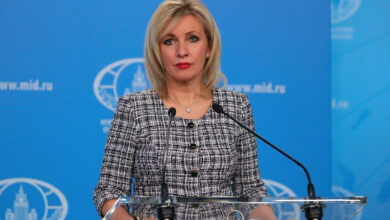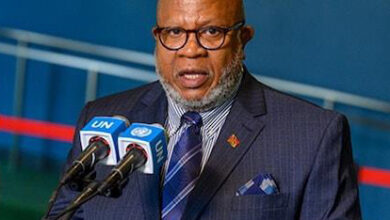India Welcomes the US with more Defence Deals

New Delhi. India and the US will move forward with more defence deals but New Delhi is unlikely to concede to Washington’s pressure on cancelling the S-400 missile defence agreement with Russia.
US Secretary of State Michael Pompeo, here on a day’s working visit June 26, was extended a warm reception by his counterpart, External Affairs Minister S Jaishankar, and indications were that notwithstanding the US concerns over the slow acquisition process in India and New Delhi’s sourcing of military equipment With Love From Russia – to quote a James Bond film title – there was firm agreement on a couple of items, General Atomics’ Predator drones for the three Services, and Raytheon’s NASAMS (National Advanced Surface to Air Missile System) for the Indian Air Force (IAF) for a layered missile defence over western India and the New Delhi capital region, which already has Russian and Israeli anti missile system.
Pompeo called on Prime Minister Narendra Modi with a message from President Donald Trump before getting into delegation level talks with Jaishankar, a career diplomat who has been an ambassador in Washington and has dealt with the US for more than a decade ever since he was Joint Secretary Americas in the Indian External Affairs Ministry.
Pompeo also met with NSA (National Security Adviser) Ajit Doval, the key player in defence and foreign affairs for India.
Prime Minister Modi and President Trump met later to reaffirm the warm bilateral relations on the sidelines of the G-20 summit hosted by Japanese Prime Minister Shinzo Abe in Osaka.

The Indo-US agenda of defence diplomacy covers priority requirements, particularly for the Indian Navy, 10 General Atomics SeaGuardian drones, 10 Boeing P8-I Maritime Surveillance and Anti Submarine Warfare aircraft and 24 Lockheed Martin MH-60R multirole helicopters. NASAMS, built by the Number 1 US war technology company Raytheon, have apparently been included to placate Washington pressures over the S-400, which New Delhi has declined to cancel.
There has been no agreement on Raytheon’s offer for its Patriot anti-missile system but components of the company’s Stinger Air-to-Air Missile, which are onboard the Apache helicopters, are to be manufactured by the Tata group. This AAM is on offer to India for integration on HAL-made Light Combat Helicopter as well as the armed Dhruv, designated by the Indian Army as Rudra.
The US has however not cleared the sale of the hand-held variant of the Stinger, which the Pakistani army stole from US forces in Afghanistan and has used against Indian aircraft since the 1999 Kargil war.
Raytheon was the first US company to sell modern US equipment to India with the Army buying its AN/TPQ-37 WLRs (Weapon Locating Radars).
Boeing has already done deals exceeding $15 billion with India, selling its C- 17 heavy lifter, Chinook CH-47F heavy lift helicopter, P8-Is and Apache AH- 64E attack helicopters whose first lot of four is due in July and another eight shortly thereafter. A total of 22 for IAF and six for the Army Aviation Corps are being acquired in due course.
IAF has also inducted and integrated 12 Lockheed Martin C-130J Special Ops transport aircraft, and there is some discussion between this company and ISRO (Indian Space Research Organisation) for possible cooperation in India’s space ventures.
The US is looking at two mega deals with India, the sale of Lockheed Martin F-21 or Boeing F-18 Advanced Super Hornet in the round two of IAF’s quest for 114 Medium Multi Role Combat Aircraft to be progressively made in India, and 57 aircraft carrier variants for which the Boeing F-18 and French Dassault’s twin-engine Rafale are in contest.
Long term maintenance support for whatever the Indian forces buy is also a lucrative arrangement that the US and other companies look for.
According to State Department spokesperson Morgan Ortagus, “Secretary Pompeo underscored the strong US commitment to working closely with the new Indian government to advance our strategic partnership” adding the two “share the US and Indian objectives in safeguarding a free and open Indo-Pacific, US-India Security Cooperation, and the US-India economic partnership.”

Jaishankar has acknowledged some differences but said before the meeting that diplomacy is about sorting them out.
The US has concerns with India on enforcing its policy of isolating Russia and Iran, for different reasons, and is also frustrated with New Delhi for delayed – or slow – pace of implementation of some defence deals which the Trump administration went out of the way to clear at India’s request. The case of General Atomics long range SeaGuardian unmanned surveillance aircraft for the Indian Navy is one such issue.
India opens many fronts, wanting this and that, and then drags feet over slow movement or files, indecisions, and updating requirements midway, observed a top US industry leader.
As for the Indian Navy, it wanted 22 of these propeller driven aircraft, and a mention was made at the highest level during Modi’s visit to Washington a couple of years ago. Technology upgrade to arm them was also sought, and possibly agreed to by the US State and Defense Departments.
Then the Indian Air Force (IAF), and later Army, also expressed interest, and the Ministry of Defence (MoD), which is faced with a cash crunch, diluted the numbers for the Navy to 10, and made an allocation in principle for a similar number, 10 each, for them also.
IAF though is keen for the jet-powered armed General Atomics Avengers, but diplomatic sources say they would come after all that is on the table now is progressed well.
Pompeo meanwhile has urged the Indian side to align the Indian foreign policy with that of the US, at least with regard to Russia and Iran, the latter accused of attacks on oil tankers near the strategic Strait of Hormuz or in the Gulf of Oman.
For India, these proposals are just about impossible.
Iran is a neighbour, and India has always been importing oil from it, the current supply being about 10 per cent of the total imports. Nonetheless, India has taken some steps to reduce that flow.
Cutting defence ties with Russia is another matter, and more than impossible, given the history of South Asia.
Ever since the US armed Pakistan in the 1950s and 1960s, eventually leading to the creation of religious terror structures by the Pakistani army under General Zia–ul-Haq in the 1980s, India has had to rely on the Soviet Union – and now Russia – for military hardware. Russia has supplied India with nuclear technology for submarines and the Indian armed forces depend upon Soviet origin/Russian equipment to the extent of 70 per cent including most of IAF aircraft, naval ships and army’s tanks and guns and rifles and whatever.
The advanced S-400 missile defence system is the latest on India’s requirements. Washington specifically wants that cancelled. India cannot but continue to source military equipment proverbially From Russia With Love due to the geopolitical and historical realities.
What is workable for India is to buy more from the US, by way of new orders or repeat. This seems to be happening.





